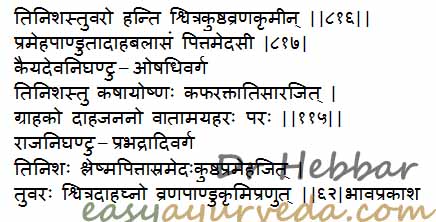Tinisha – Ogeinia dalbergioides Uses, Dose, Research
Tinisha – Ougeinia dalbergioides is an Ayurveda herb used in the treatment of Vitiligo, diabetes, anemia, non healing wounds and ulcers. The wood from this tree was used previously to make the wheels of a chariot Botanical Name- Lagerstroemia speciosa, Ougeinia dalbergioides Benth.
Synonyms: Ougeinia oojeinensis Roxb.
Family- FABACEAE (Simbi kula / Aparajita upakula)
Table of Contents
Vernacular names
Names in different languages:
Hindi Name- Sadana
Malayala Name- Malavenna
Telugu Name- NemmiChettu
Kannada-Kurimutala
Tamil Name- Narivengai
Sanskrit synonyms
Syandana, Sarvasara, Ashmagarbha, Shukra Samvarana, Nemi, Shakata, Bhasmagarbha, Meshi, Jaladhara
Rathi, Ratha, Rathadru, Rathvruksha- The wood is strong and hence used to build the wheels of chariot (ratha).
Vanyataru- Tree found in the forests
Categorization
Classical categorization:
Sushruta- Salasaradi gana
Vagbhata- Asanadi gana
Kaiyyadeva Nighantu- Oushadivarga
Raja Nighantu- Prabadradivarga
Systemic classification:
Kingdom: Plantae
Sub kingdom: Phanerogamia
Division: Angiospermia
Class: Dicotyledons
Subclass: Calyciflora
Natural order: Leguminosae
Sub Order: Papilionaceae
Habitat, chemical constituents
Habitat-
The tree of Tinisa grows up to a height of 10-15 m in the mountain regions northern and central parts of India with pale pink colored flowers in bunches.
Properties
Rasa (Taste) – Kashaya – astringent
Veerya (Potency) – Sheeta – cold
Guna (Qualities) –Laghu – light for digestion, Ruksa- dry in nature
Vipaka- Katu- pungent after digestion
Karma- Kapha- Pitta hara, Medohara
Ougeinia oojeinensis Major chemical constituents:
The leaves and heartwood of Tinisha contain iso-flavonoids-dalbergion, hemoferitin and urgenin. Leaves also contain the flavonoids- kaempferol, quercetin and leuco pelargonidin. The stem bark contains lupeol, botulinum and about 7% tannins. The heartwood also contains oujenin and homoferreirin.
Sanskrit verse

Dosage, part used
Dosage: 40-50 ml of decoction in divided doses
Paste of the bark is used for external application
Useful part-The heart wood and bark are the useful parts of the tree Ougeinia dalbergioides
Uses, Effect on Doshas
Uses of the Tinisha:
The paste of the bark is applied externally to treat wounds, swollen joints and skin diseases like vitiligo, scabies
Decoction is prepared from the bark or the heartwood of OugenisdalberioidesBenth. along with the bark of priyala (Buchanania lanzan ), shalmali (Shalmalia malabarica), plaksha (Ficus lacor). The prepared decoction is given along with honey in a divided dose of 40-50 ml in diarrhea, bleeding piles.
The decoction of the heartwood is given in a dosage of 40-50 ml in divided doses in fever, burning sensation of the body and soles of the foot.
The decoction of tinisha is used as a rejuvenator i.e to strengthen the nerves.
The heartwood decoction is given in patients suffering from diabetes.
Effect on Tridosha- Tinisha is kapha pitta shamaka (reduces the vitiated kapha and pitta dosha)
Interaction with medicines, supplements
Can this be used while taking Homeopathic medicine?
Yes. This product does not react with homeopathic medicine.
Can this medicine be continued while taking supplements like multivitamin tablets, Omega 3 fatty acids etc?
Yes. Generally, this product goes well with most dietary supplements. However, if you are taking more than one product per day, please consult your doctor for an opinion.
With western
medicines
Seek your
doctor’s advice if you are taking this product along with other western
(allopathic / modern) medicines. Some Ayurvedic herbs can interact with modern
medicine.
If both Ayurvedic and allopathic medicines are advised together, then it is
best to take Allopathic medicine first, wait for 30 minutes and then take the
Ayurvedic medicine.
Ayurveda medicines
Ayurveda medicines containing Tinisha:
(Click on the medicine name to know more about them)
Asanadi Kashayam – used in the treatment of diabetes, skin diseases and obesity etc.
Ayaskriti – used in anemia, weight loss therapy, skin diseases etc.
Research works
- The extract of the whole plant tinisa showed anti-inflammatory, hypotensive, hepato protective action
- The methanol extract of the leaves of tinsia plant showed anti-microbial activity.
- In an experimental study carried in mice, the ethanol extract of the bark of the plant showed anti- depressant activity.
- The bark and root extract of the plant showed anti diabetic properties in the experimental studies carried out in rats.
Author:
Dr.B.K.Prashanth M.D (Ayu), Ph.D, E mail: [email protected] and Dr Hebbar
Sthanika Karma (Systemic Action)
External Application – It has wound healing, Anti inflammatory actions. Paste is used in wounds to promote faster healing.
Internal administration-
Digestive system – Absorbent in nature. Indicated in Dysentery, diarrhea etc.
Circulatory System – Indicated in bleeding disorders
Excretory system – reduces urine output. decoction prepared out of its stem is indicated in diabetes.
Tvak – Indicated in skin disorders
Satmikarana – Rejuvinative and is indicated in general debility










2 comments
Ravi
Is the herb readily available in the market by the same name ? Is it available like GILOY KWATH or LICORICE KWATH ?
Dr J V Hebbar MD(Ayu)Author
No. It is not readily available in the market.